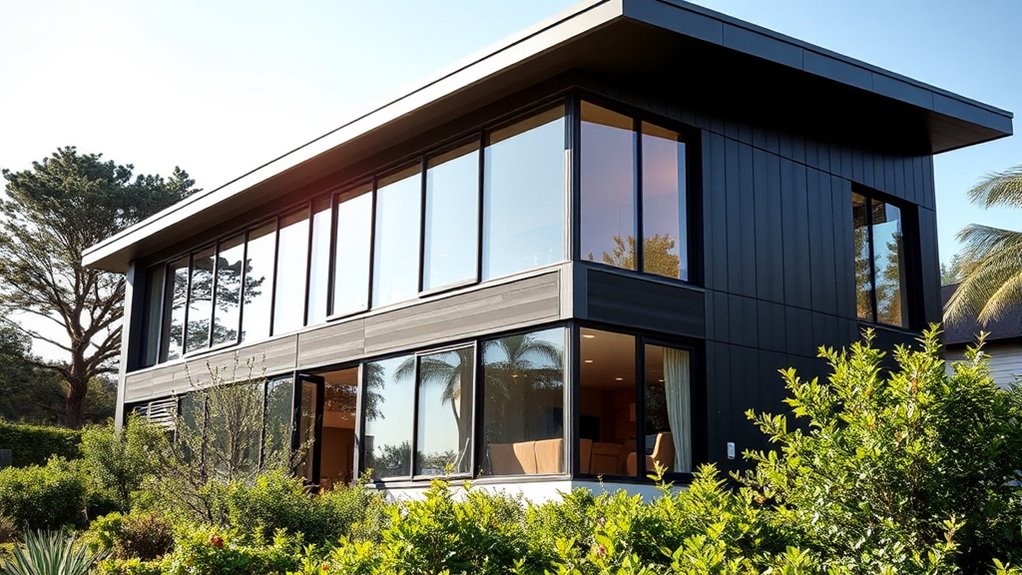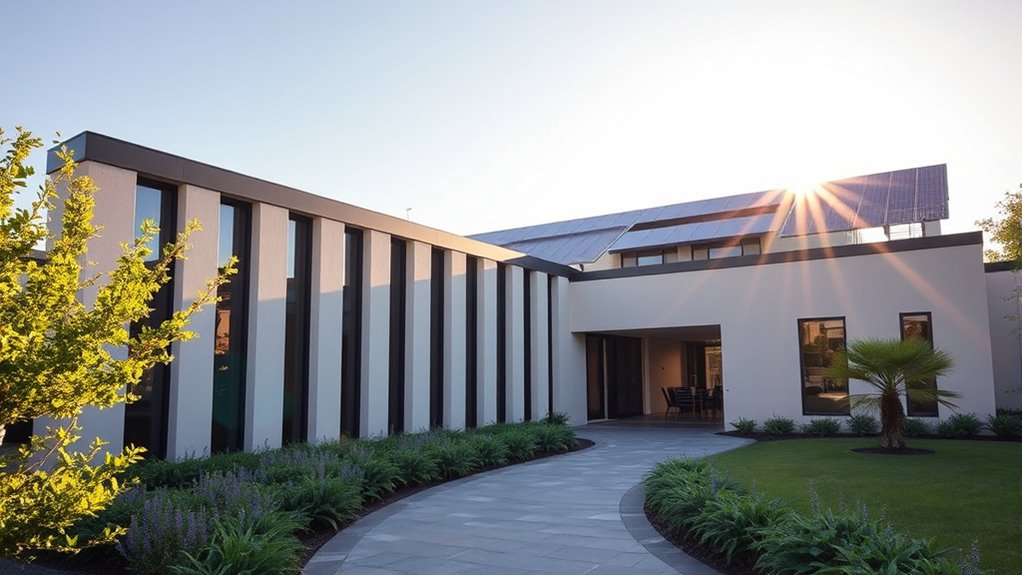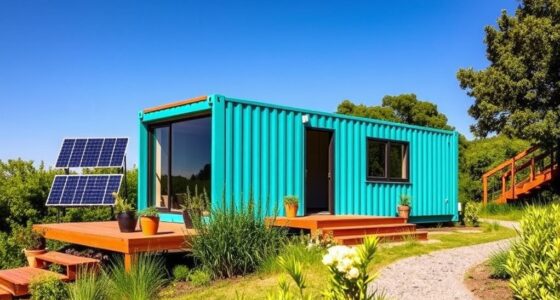To optimize passive gains, you should orient your building to face the sun’s path, especially on the southern side in the northern hemisphere, to maximize solar heating and daylight. Position windows and shading devices thoughtfully to capture winter sun while blocking high summer rays. Consider prevailing winds to facilitate natural ventilation and reduce cooling needs. Small adjustments in building placement and design can notably improve energy efficiency—continue exploring to uncover more strategies for a sustainable, comfortable space.
Key Takeaways
- Orient buildings to face the sun’s path, especially on the southern side in the northern hemisphere, to maximize solar gain.
- Use overhangs and shading devices to block high summer sun while allowing winter sunlight penetration.
- Position windows and openings strategically for effective daylighting and natural ventilation.
- Incorporate landscape features like trees to direct prevailing winds for enhanced cross-ventilation.
- Combine solar gain and wind flow strategies to create a passive, energy-efficient building system year-round.

Optimizing building orientation is essential for maximizing passive gains and reducing energy costs. When you position a building thoughtfully, you leverage natural elements like solar gain and wind flow to maintain comfortable indoor temperatures without relying heavily on artificial heating or cooling systems. This strategic placement allows sunlight to penetrate your space during winter months, warming rooms naturally, while minimizing excessive heat during summer. Proper orientation ensures that your building captures the sun’s energy efficiently, reducing reliance on energy-intensive climate control.
Thoughtful building orientation harnesses natural sunlight and airflow to reduce energy costs and enhance comfort naturally.
Solar gain plays a pivotal role in passive design. By facing your building toward the sun’s path, especially on the southern side in the northern hemisphere, you can maximize sunlight exposure. Large, well-placed windows on this side allow daylight to flood your interior, reducing the need for artificial lighting. Overhangs or shading devices are also important; they block high summer sun while letting in low winter rays. This balance reduces overheating during warmer months and enhances warmth during colder times. Thoughtful placement of windows and shading based on your location ensures you harness solar gain effectively, contributing to energy savings and increased comfort.
Wind flow is equally crucial in passive building design. You need to consider the prevailing wind patterns in your area to facilitate natural ventilation. Proper orientation can help catch breezes that cool your building during hot weather, lowering the need for air conditioning. Positioning vents, windows, and openings strategically on opposite sides of your structure encourages cross-ventilation, which helps remove heat and maintain fresh indoor air. Additionally, landscaping features like trees or shrubs can direct wind toward your building, enhancing airflow. By understanding and utilizing wind flow, you create a natural cooling system that reduces energy consumption and improves indoor air quality.
When you combine an orientation that maximizes solar gain in the winter with strategies to harness wind flow for cooling in the summer, you develop a passive system that works year-round. This approach not only decreases your energy bills but also makes your building more sustainable and resilient. You should analyze your site’s sun and wind patterns before designing or renovating, ensuring your building’s orientation takes full advantage of these natural forces. Small adjustments, like shifting the building’s angle or adding shading devices, can considerably impact performance.
In essence, paying close attention to building orientation allows you to turn natural elements into powerful allies in energy efficiency. By optimizing for solar gain and wind flow, you minimize your environmental footprint while enjoying a more comfortable, cost-effective living or working space. This proactive approach in passive design underpins a smarter, greener way to build and maintain buildings for the future. Additionally, understanding GMC tuning principles can inspire innovative ways to incorporate energy-efficient technologies into your building systems for enhanced passive gains.
Frequently Asked Questions
How Does Local Climate Influence Optimal Building Orientation?
You should consider local climate because it directly affects solar gain and wind direction. In hot climates, orient your building to minimize sun exposure, reducing cooling needs, while maximizing wind flow for natural ventilation. Conversely, in colder areas, maximize solar gain by facing windows toward the sun and use prevailing wind directions to enhance airflow. Adjusting building orientation based on these factors helps optimize energy efficiency and comfort throughout the year.
Can Building Orientation Impact Energy Costs Year-Round?
Your building’s orientation dramatically impacts your energy costs year-round, like a giant thermostat working overtime. Proper alignment enhances ventilation strategies and maximizes thermal mass considerations, reducing heating and cooling needs. By orienting your building to optimize sunlight, airflow, and thermal retention, you can slash energy bills considerably. It’s like turning down the thermostat naturally—saving money while maintaining comfort, no matter the season.
Are There Specific Orientations Better for Solar Panel Efficiency?
You should orient your building to maximize solar gain and minimize wind exposure for ideal solar panel efficiency. Facing panels south in the northern hemisphere captures the most sunlight year-round, boosting energy production. Avoid orientations that increase wind exposure, which can cool panels and reduce efficiency. Properly positioning your building helps ensure your solar panels perform at their best, saving you money and energy over time.
How Does Surrounding Landscape Affect Building Orientation Choices?
Your surrounding landscape dramatically influences your building’s orientation, almost like a secret weapon. Tall trees, hills, and water bodies can block sunlight or offer vital wind protection, so you need to carefully consider these landscape features. Privacy considerations also matter; positioning your building to shield it from neighbors or busy streets can maximize passive gains. Ignoring these factors risks energy loss, making your passive design efforts less effective and more costly in the long run.
What Are Common Mistakes in Choosing Building Orientation?
You often make mistakes like improperly placing windows, which limits natural light and ventilation, or overlooking ventilation strategies that could improve airflow. You might also ignore the sun’s path, causing excessive heat gain or loss. To avoid these errors, carefully consider window placement for ideal daylight and cross-ventilation. Incorporate effective ventilation strategies early on, ensuring your building naturally stays comfortable without over-relying on mechanical systems.
Conclusion
By paying attention to building orientation, you can harness passive gains and substantially reduce energy costs. Think of it as hitting two birds with one stone—improving comfort while saving the environment. When you prioritize smart orientation, you’re not just building a structure; you’re creating a sustainable haven that works with nature rather than against it. So, don’t wait for a wake-up call—act now and let your building do the heavy lifting naturally.









